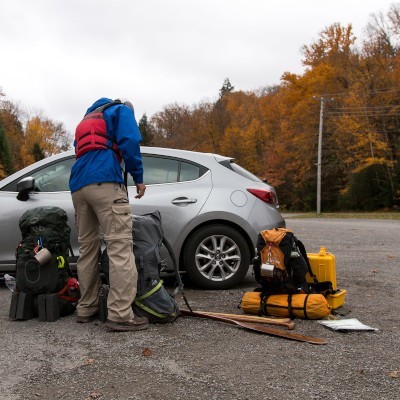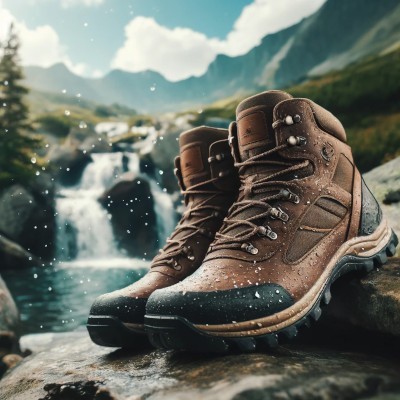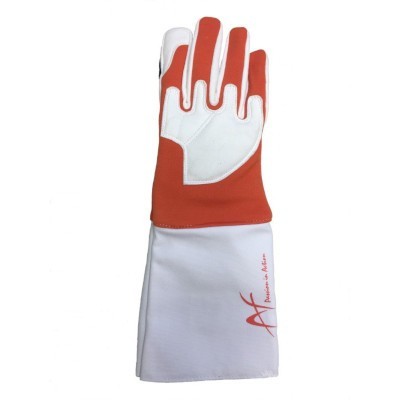Backpacking

How to orient yourself in the vast world of mountain backpacks
The mountain backpack
Choosing the right backpack for mountain excursions requires some consideration, as several factors will have to be taken into account. Here are some tips to help you choose a hiking backpack that fits your needs:
• Capacity: The capacity of the backpack is one of the most important factors to consider. It depends on the duration of your excursions and the amount of equipment you want to bring with you. Hiking backpacks are usually classified by volume in litres. For example, a day pack will have a capacity of less than 30 liters, while a pack for longer hikes might have a capacity of 50 liters or more.
• Compatibility: Make sure the backpack is compatible with your body size. Look for a backpack with a suspension system (a set of components and features that support the weight of the backpack and distribute the load evenly across the wearer's back. This system is essential for comfort, stability, and reduced fatigue during long hikes or outdoor activities) adjustable to fit your torso length. A well-fitting backpack distributes weight evenly and reduces stress on your back.
• Comfort: Check that the backpack offers good support and comfort. Padded shoulder and chest straps, ventilated back plates and a padded hip belt can all contribute to comfort during your hike.
• Organization and access: Evaluate the pockets and internal sections of the backpack. A well-organized backpack allows you to keep everything organized and easily access the items you need. Look for side pockets for water bottles, zippered pockets for valuables, and a compression system to keep your load stable.
• Resistance and waterproofing: Choose a backpack made with resistant and durable materials, so that it can withstand the wear and tear of mountain excursions. Look for a backpack with a rain cover or one made from waterproof materials to protect the contents in wet weather.
• Weight: Also consider the weight of the backpack itself. A lighter pack may be more comfortable on long hikes, but you'll need to balance weight with the need for strength and durability.
• Brands and Reviews: Explore the various hiking backpack brands available on the market and read user reviews to get an idea of the performance and quality of a specific model.
Typologies
Different types of mountain backpacks are available on the market, designed to meet the different needs of hikers.
Here are some of the more common types:
• Day Packs: These packs are ideal for day hikes or activities where you don't need to carry a lot of gear. They usually have a capacity of less than 30 liters and are light and compact.
• Hiking Backpacks: These backpacks are designed for multi-day hikes or treks where you need to carry more extensive gear. They typically have a capacity of between 30 and 50 liters and offer more storage and organization than daypacks.
• Alpine Hiking Backpacks: These backpacks are designed for tackling alpine terrain and more challenging hikes. They are robust, durable and often feature features such as separate compartment for technical equipment (such as ice ax and crampons) and attachment system for ropes.
• Climbing backpacks: These backpacks are specifically designed for climbing and feature a more minimalist and lightweight style. They usually feature straps for carrying technical gear, such as ropes and helmets, and are closer to the body to allow for greater freedom of movement when climbing.
• Expedition Backpacks: These backpacks are designed for high-altitude expeditions and long-distance hikes. They have a very large capacity, often exceeding 70 litres, and are equipped with robust lumbar belts and suspension systems to support heavy weights.
They are also designed to withstand extreme weather conditions and are usually made from highly durable, waterproof materials. In addition to these main types, there are many other variations and specialized brands that offer specific backpacks for certain activities, such as ski touring, winter hiking or light hiking.
It's important to assess your specific needs and the type of terrain and activity you'll be tackling to choose the right type of hiking backpack.
The right price
The price of a mountain backpack can affect the quality and characteristics of the product, but it is not the only determining factor. In general, you can see a correlation between the price and quality of a backpack, but that doesn't mean that an expensive backpack is always superior to a less expensive one. A higher price can be justified by several factors, including:
• High-quality materials: Backpacks made with high-quality materials, such as durable nylon, waterproof fabrics, and durable components, tend to command a higher price tag. These materials can give the backpack greater durability and wear resistance.
• Technologies and innovations: The more expensive backpacks often incorporate advanced technologies and design innovations. For example, they may have ergonomic suspension systems, ventilated back panels, adjustable straps, and specialized organizational pockets. These features can improve the comfort, functionality and ergonomics of the backpack.
• Well-known brands: Well-known brands in the outdoor sector tend to have higher prices. This may be due to their established reputation, investment in product research and development and the build quality they guarantee.
However, there are also cheaper backpacks that offer good value for money. These backpacks may not have all the advanced features of more expensive models, but they can still meet the needs of casual backpackers or those who don't need specific features.
When choosing a mountain backpack, it is important to carefully evaluate your needs and the budget available. Consider the type of hikes you intend to take, how often you will be using your backpack, and the gear you wish to bring along. Read user reviews, compare the technical specifications and, if possible, try the backpack for yourself to make sure it fits your needs, regardless of the price.
Conclusions
Before buying a hiking backpack, consider your needs, the duration of the hikes you intend to do and the type of equipment you want to take with you. Try on different styles, if possible, to see which one fits your body type best and feels most comfortable.




Comments
No comment at this time!
Leave your comment